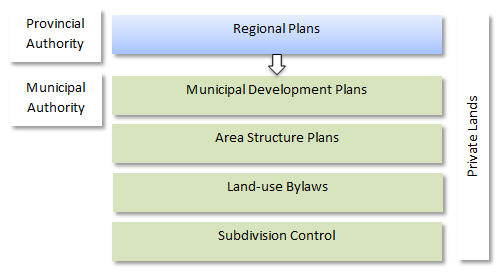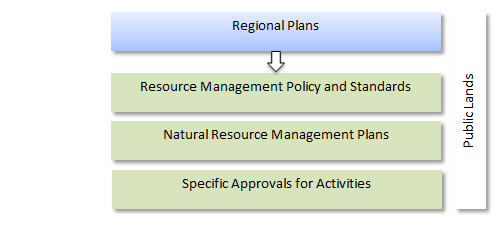Planning and Decision-making on Private and Public Lands
Planning and decision-making in Alberta are carried out under various provincial legislation and policies. These are applied by a range of decision-makers – including Government of Alberta departments, boards and agencies, and municipal governments – responsible for making decisions about activities in the region. Regional Plans apply to Crown and private lands in the region.
Private Lands
Planning on private lands is primarily governed by the Municipal Government Act and instruments made under its authority.
Municipal governments maintain their responsibility and authority for local land-use planning and development on all lands within their boundaries. This includes the creation of municipal development plans, area structure plans and land-use bylaws. This delegated authority will remain with municipalities. Municipal planning and development decisions will, however, have to be in alignment with the regional plan to achieve the regional outcomes established in the plan.
Métis Settlements maintain their responsibility and authority for local land-use planning and development on settlement patented land.
Private landowners make decisions about how to use and manage their land consistent with existing provincial and municipal legislation. Regional plans do not change this or alter private property rights.
Regional Plans, including sub-regional plans, does not rescind land title or freehold mineral rights. Any decisions that may affect private landowners or freehold owners will occur through existing legislation and processes, and private landowners and freehold owners remain entitled to due process. Private landowners may be entitled to compensation under those laws.

Provincial Crown Lands
Crown lands include lands that are administered as public lands under the Public Lands Act or Special Areas Act, parks under the Provincial Parks Act and highways under the Highways Development and Protection Act. Crown lands are owned by the Crown and managed for the benefit of all Albertans. The Government of Alberta often allows individuals and businesses to use public lands through statutory consents that grant permission to do certain activities on public land – such as livestock grazing, tree harvesting, energy development or recreational use. In addition, the Government of Alberta grants statutory consents related to the use of, or impacts on, public resources (like water) to allow or support specific development, industrial activity, conservation or other activities.
On public lands, direction under a regional plan will be delivered through existing legislation such as the Public Lands Act, the Forests Act and the Provincial Parks Act and through existing tools such as integrated resource plans, access management plans and forest management planning. These further define access to and use of provincial Crown land, and focus on operational activities that reflect the regional priorities and direction.

Informing Land-use Decisions
Regional plans will be implemented by those who already make land-use decisions. Decision-makers are those having legal authority to grant some form of statutory consent, such as a development permit, a water licence or a project approval. Decision-makers include municipal governments and Government of Alberta departments, boards and agencies and other organizations. Local government bodies and decision-making bodies will be required to ensure their regulatory instruments comply with a regional plan. They must also use the regional plan to inform their policies.
The implementation of regional plans must follow the laws of Alberta. All decisions that implement regional plans will be made through existing laws. All rights to appeal, requirements for due process and rights to compensation enjoyed by landowners and rights holders under these laws are not changed by a regional plan.
Aboriginal Peoples
Alberta recognizes that those First Nations and Métis communities that hold constitutionally protected rights are uniquely positioned to inform land-use planning. Consulting aboriginal communities on regional planning, particularly those aspects that have the potential to adversely impact their constitutionally protected rights, and reconciling interests are essential to achieving the regional vision. In accordance with applicable government policy as it may be from time to time, the Government of Alberta will continue to consult with aboriginal peoples when government decisions may adversely affect the continued exercise of their constitutionally protected rights, and the input from such consultations continues to be considered prior to the decision.
Other Jurisdictions and Regions
Co-ordination with other jurisdictions such as the federal government, provinces and territories, and other Land-use Framework regions, will be required to ensure alignment of regional outcomes, and that objectives and strategies are achieved.
